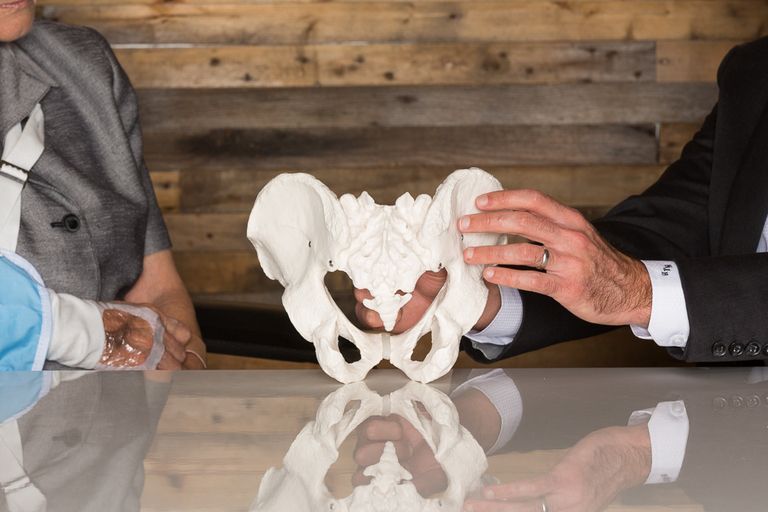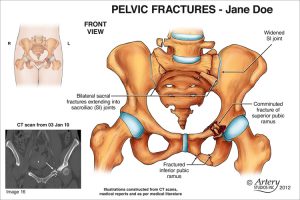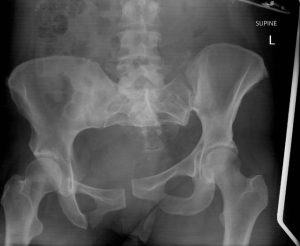Attorneys Helping Nursing Home Victims of Pelvic Fractures
Broken Pelvis Injuries in Nursing Homes Suggest Neglect and Require Investigation
The pelvis, a ring of bones located in the lower torso, connects the hips and protects vital organs in the abdomen. Pelvic fractures are painful, life threatening injuries in elderly nursing home patients. Unfortunately, broken pelvis injuries are common if the nursing home neglects the resident and allows them to suffer a fall.
If your loved one suffered a pelvic fracture or broken bone in a long term care facility, contact the compassionate and experienced nursing home neglect attorneys at Senior Justice Law Firm. Elder abuse and neglect cases are all that we do.
Receive your complimentary broken pelvis case consultation today: 1-888-375-9998
Broken Pelvis from a Nursing Home Fall or Trauma

The pelvis is an important structure of bones within the body that include the sacrum, tailbone (coccyx), and hip bones (ilium, ischium, and pubis). These bones connect to form a protective ring, also known as the pelvic ring, around vital organs, nerves, and blood vessels.
Nursing Home Pelvic Fractures can be Divided into Three Categories
- Low-energy pelvic fractures that arise from low-energy trauma (i.e. falls while standing/walking)
- High-energy pelvic fractures that arise from major, high-energy trauma (i.e. automobile accidents)
- Avulsion pelvic fractures that arise from muscle convulsions (no specified traumatic event)
Pelvic fractures that arise in nursing homes and other assisted living homes usually fall into the first category listed above. Though these fractures can be classified as “minor” pelvic fractures, they should by no means be trivialized.
Broken Pelvis in Nursing Home Residents: The Ramifications
Pelvic fractures in the elderly can take up to a year to heal and cause a multitude of secondary complications, including wrongful death.
Those who recover from pelvic fractures generally suffer a drastic decrease in mobility and require a cane, walker, wheelchair or other means of assistance to walk. There is oftentimes residual pain with movement in the pelvic area. There is also a resulting loss in the range of motion in the pelvic, hip and femur bones. All of this can result in the loss of the ability to walk, radiating pain upwards to the spine or downwards to the legs, and robbing an already compromised patient of their independence.
Obviously, nursing home falls resulting in pelvic fractures are a catastrophic loss for the victim. Therefore, it is important that at-risk patients within nursing homes are adequately supervised and assisted so as to lessen the possibility of pelvic fractures.
Causes of Pelvic Fractures in Nursing Home Residents
 Pelvic fractures are a risk for those with certain underlying conditions, such as osteoporosis, brittle bones, vitamin D deficiency, advanced age, Paget’s disease, rheumatoid arthritis, and multiple myeloma. All of these conditions are known to weaken the bones, making them prone to fractures and breaks. Those with the greatest risk of acquiring pelvic fractures are elderly osteoporotic women. Many nursing home residents suffer from these risk factors, and as a result, patients in nursing homes are more likely to suffer a broken pelvis from a nursing home fall.
Pelvic fractures are a risk for those with certain underlying conditions, such as osteoporosis, brittle bones, vitamin D deficiency, advanced age, Paget’s disease, rheumatoid arthritis, and multiple myeloma. All of these conditions are known to weaken the bones, making them prone to fractures and breaks. Those with the greatest risk of acquiring pelvic fractures are elderly osteoporotic women. Many nursing home residents suffer from these risk factors, and as a result, patients in nursing homes are more likely to suffer a broken pelvis from a nursing home fall.
Osteoporosis is a Risk Factor, Not a Cause of a Broken Pelvis!
Osteoporosis weakens an elderly person’s bones. But brittle bones do not break a pelvis. Trauma causes a broken pelvis.
Unfortunately, the presence of weakened bones means that even small shocks to the body can lead to fractures. An older individual with osteoporosis can fracture their pelvis by slipping in the shower, falling out of bed, being dropped by a caregiver, or merely sitting down too hard on in a wheelchair. Because elderly patients with osteoporosis have such a high risk for developing serious pelvic fractures, nursing homes must develop and abide by multiple safeguards to reduce the risk for falls and fractures.
The fact that a nursing home resident has osteoporosis does not excuse a pelvic fracture. It only means that the nursing home is on notice that this patient is at risk for fractures and must supervise and assist them that much closer to prevent a broken pelvis.
Prevention of these pelvic fractures in at-risk residents is discussed in detail in the below paragraphs.

Falls and Broken Pelvis Injuries in Nursing Home Residents
Falls are very common among older adults in nursing homes. With up to 90% of nursing home patients suffering from osteoporosis, even a minor fall has the danger of fracturing a patient’s fragile bones. It is vital that nursing homes establish strategies and safeguards to reduce the risk for falls and fractures. Examples of these strategies and safeguards include:
- Administering medication and supplements to improve bone density
- Giving the patient occupational therapy to improve balance and strength
- Offering ambulatory aids (i.e. handrails, walkers, canes, wheelchairs)
- Placing alarms on the patient’s bed
- Keeping the patient’s bed in a low position
- Placing commonly used items (i.e. glasses, water, phone, remote) within easy reach
- Answering call bells timely
- Frequent welfare checks on the patient
- Toileting schedules to prevent urgency in going to the bathroom
- Appropriate staff numbers so the ratio of patients to nurses is reasonable
- Avoid aggressive physical therapy to the pelvis area
- Fall mats to cushion pelvic injuries in the event the patient rolls out of bed
- Side rails to keep a patient from falling out of bed
- Human assistance with toileting and walking around the facility
In the situation that a pelvis fracture is suspected, there are several protocols that medical staff and caregivers are advised to follow during their treatment of the patient. Doctors are advised not to “spring the pelvis” during patient exams, patients must be moved using a straight lift (no rolling) with several persons assisting, and cushions should be provided for chairs and wheelchairs.
Downstream Injuries Associated with Pelvic Fractures in Older Patients
Caregivers should also be aware that older individuals have a higher risk of developing secondary complications during their recovery from a pelvic fracture. These added complications include:
- Bedsores
- Pneumonia
- Urinary tract infections
- Depression
- Anxiety
- Insomnia
- Infection
- Weight loss
Treatment of Nursing Home Broken Pelvis Injuries
Treatment measures vary depending on the location and severity of the pelvic fracture(s). Low-energy pelvic fractures from nursing home falls typically manifest as stable fractures with minimal bone displacement. As a result, low-energy pelvic fractures usually do not require surgical intervention. Treatment consists of imaging (X-ray and CT scan) to monitor the fracture and a walker and/or wheelchair to assist with mobility. In most instances, a prolonged period of bed rest will be required. In elderly patients, being bed-bound for a lengthy time can bring about a whole host of other health issues, as described above. The patient will be prescribed physical therapy, anti-coagulants, and pain-relief medication while their fracture heals.
If a pelvic fracture is deemed unstable, the bones have become (or at risk of becoming) significantly displaced. Large movement of the pelvic bones can cause damage to the underlying vessels and/or organs within the pelvis, which in turn can cause fatal hemorrhaging, sepsis, thrombosis, or pulmonary embolism. Surgical intervention is required to stabilize the bones. Stabilization methods include external fixation and internal fixation of the bones using metal pins, screws, and rods. Once the bones are stabilized, the patient must undergo a long period of bed rest with anti-coagulant and pain-relief therapy.
One type of pelvic fracture that has a unique treatment option is a sacral insufficiency fracture. Sacral insufficiency fractures are fractures to the sacrum (bone above the tailbone) that occur frequently to those suffering from osteoporosis. Sacral insufficiency fractures can develop from a minor fall on the butt or by simply sitting down too hard on a chair. A surgical procedure known as sacroplasty was introduced in 2002 in order to treat sacral insufficiency fractures. During sacroplasty, bone cement is injected into the fracture in order to restore the bone integrity.
Unfortunately, many elderly nursing home residents who suffered a pelvic fracture from a fall in the facility are too weak to undergo this surgery. As a result, they must live with the pain from the broken pelvis for the remainder of their life.
Lawsuits Regarding Pelvic Fractures in Nursing Homes and Assisted Living Facilities
Unfortunately, pelvic fractures have been known to occur in nursing homes due to the negligence of staff and caretakers. In many cases, safety measures such as bed alarms, welfare checks, floor mats and bed rails were not put in place despite the patient having a history of falls. Many times, staff will ignore a resident’s call bell, leading to a fall. More glaringly, facility nurses may accidentally drop a resident, resulting in a broken pelvis.
If a nursing home fails to implement the appropriate safety measures for a patient, it is the nursing home’s responsibility to pay for any resulting injury and corresponding pain and suffering.
Broken Pelvis Case Against a Nursing Home: Real Life Examples
One example in which a nursing home did not implement the necessary safeguards is described as follows: An elderly female nursing home patient, in an episode of confusion and agitation, got out of her bed to tend to the window curtains. Despite the patient’s history of falls, no bed alarms had been installed on her bed. As a result, no one came rushing into her room when she got out of bed. Additionally, she was not given anti-slip socks and there were no mats to cushion her fall. She subsequently fell and fractured her pelvis.
In another example of a caretaker’s negligence, an elderly patient fractured his pelvis during vehicular transport. The driver sped over speed bump and the patient fell from her wheelchair and the ensuing trauma from the wheelchair fall fractured the patient’s pelvis.
In both of the cases described above, the victim’s family retained our firm and took legal action to bring a case of negligence against the nursing home via a pelvic fracture lawsuit.
Speak with a Lawyer Now About Your Broken Pelvis Claim
Pelvic fractures are a serious risk for the elderly and a painful injury that your loved one should not have to suffer. Nursing home staff and employees must remain vigilant against situations that place an elderly patient at risk for falls and fractures. If you feel that a pelvic fracture was a cause of negligence or that proper reactionary steps were not taken, the attorneys at Senior Justice Law Firm are here to help you and your family.
Call us now for your free, no obligation pelvic fracture case consultation at 1-888-375-9998.
Updated 6-7-2020


